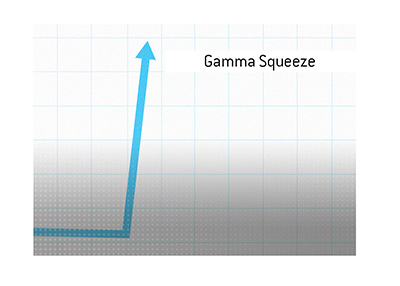Definition of Gamma Squeeze
What does the term "Gamma squeeze" mean in the world of the stock market? What is meant by a "gamma squeeze"?
 Over the past few weeks, you may have heard the term "gamma squeeze" being used, especially in regards to the big upwards moves seen in stocks such as Gamestop and Tesla.
Over the past few weeks, you may have heard the term "gamma squeeze" being used, especially in regards to the big upwards moves seen in stocks such as Gamestop and Tesla. Now, this topic can get very complicated, so I'm going to keep it simple so that you get the basic idea of a "gamma squeeze".
When you buy a stock option, there is a very good chance that a market maker is the entity that is selling it to you.
Market makers do exactly that - they make markets. They are selling options to people that want to buy them, and they are buying options from people that want to sell them.
Market makers make their money from pocketing the difference between the bid and ask - also known as the "spread".
Now, if a stock like Gamestop has a bunch of traders buying call options because they believe that the stock is going to go up, the market makers will want to hedge their risk - after all, they don't want to sell a bunch of naked options, as that leaves them exposed to a potentially massive loss.
So what do they often do? They'll buy shares of the stock in order to hedge.
Now, the market makers calculate how many shares that they need to buy based on the "Delta" of the option that they have sold. The higher the Delta, the more shares that the market maker will need to buy to hedge their positions. The closer an option is to being "in the money", the higher the Delta.
Now, "Gamma" is the rate of change of the Delta. In simple terms, the closer to the money that the option is, the higher the Gamma.
So, let's say that a market maker sells a bunch of far out-of-the-money calls to a retail trader. They buy some shares, based on the Delta of the option, to offset their risk. A stock option that is right at the money might have a Delta of 0.50, while the far out-of-the-money options might have a delta of 0.25.
The stock begins to rise.
In order to hedge their position properly, the market maker needs to buy more shares, as the Delta and Gamma rise. Gamma is at its highest level when the option is right at the money.
This creates a loop - as the stock gets closer to the money, the market maker needs to buy more shares to offset their risk, and the stock continues to rise.
In recent years, retail traders have discovered options trading en masse, and this has created some big headaches for market makers.
With retail traders hammering call buys on stocks like Tesla and Gamestop, this has created situations where market makers are scrambling to buy shares in order to hedge their positions.
Combine this with stocks that have very large short positions (such as Gamestop), and you have some very explosive situations.
-
As the Gamma of the stock option increases, this means that the option is getting closer to being at-the-money.
So, if a market maker sells far OTM (out of the money) options, they will be forced to buy more and more shares as the Gamma of the option increases.
This is why it is called a "Gamma Squeeze".
--
Davemanuel.com Articles That Mention Gamma Squeeze:
Volatility Reigns Supreme As Robinhood IPOs
WallStreetBets Targets RKT (Rocket Companies, Inc.); Stock Soars
"Roaring Kitty" Hit With Class Action Lawsuit in Massachusetts
Robinhood Sees Surge in New Accounts, Downloads
Will Robinhood Go Bankrupt This Year? Bookmaker Puts Odds at Better Than 50%
